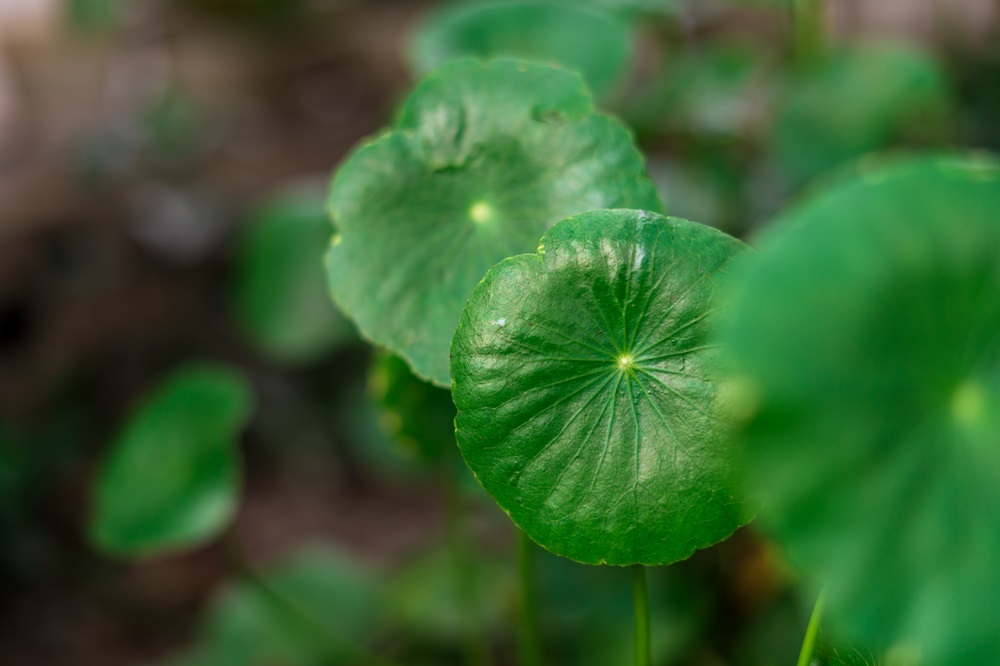Gotu Kola – Effects and Uses. What Are the Properties of Centella Asiatica?

Gotu kola is a modest-looking plant with adaptogenic potential and a wide range of uses. Centella asiatica can support the nervous system, aid wound healing, and stimulate collagen production. This aromatic herb, used in both cosmetics and dietary supplements, enjoys worldwide popularity. Gotu kola - what can it help with? How should it be used? Gotu kola contraindications - is it suitable for everyone?
Table of contents
Gotu kola - what is Centella asiatica?
Gotu kola (Centella asiatica), also known as Indian pennywort, Asiatic pennywort, or tiger grass, is an umbelliferous plant from the parsley family. It grows in tropical and subtropical regions, found in South and Central America, parts of Africa, Australia, and South Asia. It prefers warm, humid, and sunny wetland areas, often near bodies of water or rocky terrain. It can grow at altitudes up to 700 m above sea level.
Centella asiatica is a perennial aromatic herb highly valued in Chinese culture. It has a vertical taproot and creeping stems with nodes that produce long-petioled leaves and small stipules. The rounded leaves have a scalloped edge and smooth surface. Its umbel inflorescence holds 1–5 small flowers, which may be white, deep pink, or red. The plant produces small oval fruits. Its appearance may vary depending on environmental conditions.
For herbal use, the whole plant or just the aerial parts – leaves and stems – are harvested.
Centella asiatica - active compounds
Widely used for centuries in Asian countries, gotu kola is gaining recognition elsewhere thanks to its rich composition and beneficial properties.
It contains triterpenoid saponins, such as brahmoside, asiaticoside, and madecassoside, with concentrations varying by growing location. It also contains monoterpenes, sesquiterpenes, flavonoids such as rutin and quercetin, polyacetylene compounds, vitamins C, A, K, and E, and minerals such as magnesium.
Centella asiatica - properties
Gotu kola is a versatile plant widely used in Ayurveda. Traditionally, it was believed to be a source of longevity, slowing aging and supporting vision.
Scientific research suggests it is an adaptogen, helping the body resist stress and maintain homeostasis. It may benefit the nervous system and brain function – improving memory, concentration, reducing anxiety, and supporting cognitive performance.
It can also support cardiovascular health by strengthening blood vessels, improving elasticity and tone, regulating blood circulation, and protecting the endothelium. It may have anti-platelet effects and is used to improve circulation and reduce swelling in diabetic microangiopathy and venous insufficiency.
Gotu kola shows antioxidant activity, neutralizing free radicals, reducing oxidative stress, and slowing aging. It may have antibacterial and antifungal effects, promote wound and burn healing, and stimulate collagen, hyaluronic acid, and elastin production – improving skin hydration, elasticity, and appearance. It is also used to reduce cellulite and inflammation.
Gotu kola - uses
Thanks to its composition and properties, Centella asiatica is a popular dietary supplement ingredient. It is available in capsules, tablets, and sometimes drops. It can be sold as a single-ingredient product or as part of a blend with other adaptogens, such as bacopa, ashwagandha, or rhodiola rosea. The choice depends on individual needs.
In cosmetics, it is a common component of anti-aging and anti-wrinkle products, anti-cellulite formulations, and creams aimed at improving skin elasticity. It is also found in products that accelerate wound healing and in treatments for acne-prone, sensitive, or couperose skin.
Gotu kola - how to take it?
The recommended dose depends on the form used. Gotu kola can be taken internally or applied externally. It comes as dried leaves, tinctures, capsules, tablets, ointments, gels, or creams.
For herbal infusion, steep 1–2 tablespoons of dried leaves in a cup of boiling water for about 20 minutes. Usually, 1–2 cups per day are suggested. For other forms, follow the manufacturer’s instructions and never exceed the recommended dose.
Gotu kola - morning or evening?
It is generally recommended to take gotu kola in the morning or midday, as taking it in the evening may interfere with falling asleep.
Gotu kola - how long until effects appear?
Studies suggest that beneficial effects may appear after several weeks of regular use, though the exact time varies by individual response.
Gotu kola - side effects
When taken in recommended doses, Centella asiatica is considered safe. Excessive intake may cause headaches, dizziness, or digestive issues such as diarrhea, nausea, vomiting, or heartburn.
In sensitive individuals, topical products containing the herb may trigger allergic reactions such as rash, redness, or itching.
Gotu kola - contraindications
People with liver disease should consult a doctor before using gotu kola supplements. It should be avoided by individuals with low blood pressure.
It should not be used alongside barbiturates or benzodiazepines, as it may slow their metabolism, or with liver medications. It is also not advised before planned surgeries or medical procedures.

